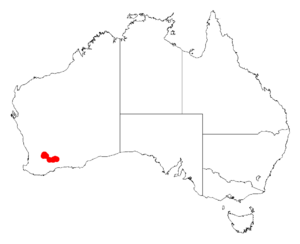Acacia tetraneura facts for kids
Quick facts for kids Acacia tetraneura |
|
|---|---|
| Conservation status | |
| Scientific classification | |
| Genus: |
Acacia
|
| Species: |
tetraneura
|
 |
|
| Occurrence data from AVH | |
Acacia tetraneura is a type of shrub that belongs to the Acacia family. It is found only in western Australia. This means it is endemic to that area.
Contents
About the Acacia tetraneura Shrub
What it Looks Like
This Acacia is a slow-growing shrub. It usually grows to be about 0.3 to 0.4 meters (about 1 to 1.3 feet) tall. It often has a flat top. Its small branches are smooth and a bit sticky, like they have resin on them. Sometimes, the very ends of the branches might have a few hairs.
Like many Acacia plants, it doesn't have true leaves. Instead, it has special leaf-like parts called phyllodes. These phyllodes are blue-green and stand upright. They can be round or flat, and they are often slightly curved inwards.
The phyllodes are stiff and measure about 2 to 7 centimeters (0.8 to 2.8 inches) long. They are about 1.5 to 3 millimeters (0.06 to 0.12 inches) wide. Each phyllode has four wide, flat-topped lines, or nerves, running along it. One nerve in the middle stands out more than the others.
Flowers and Seed Pods
Acacia tetraneura blooms from May to July. It produces yellow flowers. The flowers grow in groups called inflorescences. These usually appear in pairs where a leaf (or phyllode) meets the stem, which is called the axil.
The flower heads are round or slightly oval, about 5 millimeters (0.2 inches) across. Each head contains 13 to 20 light golden-colored flowers.
After the flowers, seed pods grow. These pods are smooth and have a tough, leathery texture. They are long and thin, but they are slightly squeezed in between each seed. The pods can be straight or twisted, growing up to 5 centimeters (2 inches) long and 2 to 3 millimeters (0.08 to 0.12 inches) wide. They have wide edges. The seeds inside are grey-brown with spots. They are oval-shaped and about 2 to 2.5 millimeters (0.08 to 0.1 inches) long.
Where Acacia tetraneura Grows
This plant is native to the Wheatbelt region of Western Australia. It often grows on low hills and raised areas. You can find it in clay soils that contain a type of gravel called lateritic gravel.
It is commonly found around the Bruce Rock area. It also grows in places southwest of Hyden. In these areas, it is part of open heathland communities. Heathlands are areas with low-growing shrubs and plants.


